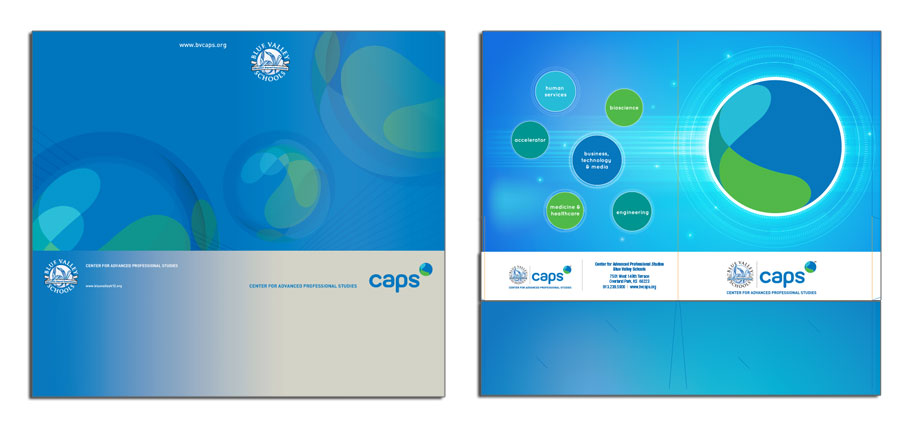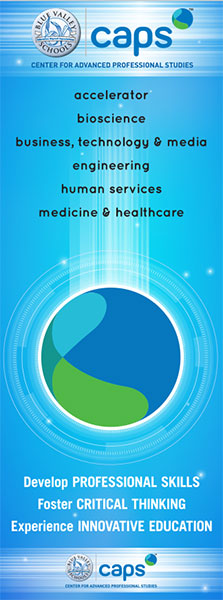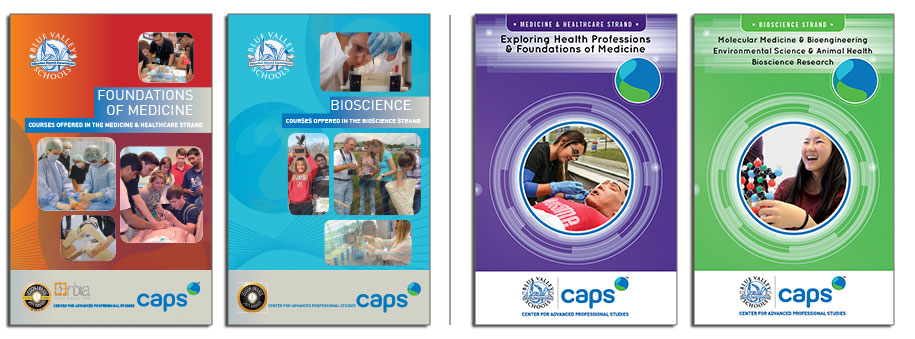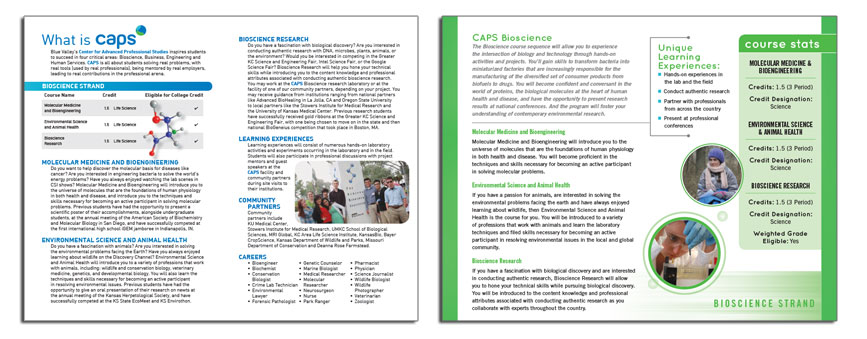In 2015, a former client of mine started working with CAPS, or Center for Advanced Professional Studies, a specialized school program for high school students in Kansas’s Blue Valley school district. The old collateral had an early-nineties Apple default desktop look to it, with a lot of unattractive gradients and curvy lines. It felt stale, unattractive, and contrary to the goals of the CAPS program itself, which is innovative, forward-thinking, and focused on new technology.

The first piece I redesigned, and the piece that served as a jumping-off point for the entire project, was a folder. The folder is used to distribute course information to prospective students, so it needed to be eye-catching enough to make someone want to look inside. I proposed three options: a circuitry theme, an icon theme, and the one that was selected, a high-tech design that invokes the idea of moving forward at high speeds, which is what this program lets students do in their education. (see right). You can see from the original the design problems I was confronting – they had a great idea in abstracting the logo, but here it just drifts and it doesn’t communicate anything about the nature of the program. My design is lighter and has a sense of energy and fun, with a richer, brighter blue and an avoidance of gray. Each course section, or “strand,” is featured prominently on the back of the folder.

The next step was a Barracuda banner. The banner sits on an adjustable holder, so it can be shorter or taller as needed. This presented a challenge – the information needed to be designed in such a way that it would be OK if some of it were hidden when the sign is being used on tabletop. I tackled this issue by moving the logo onto the middle bottom – so if it is gone, it doesn’t impact the design or the listing of the strands – and then to fill the bottom space, I wrote some copy that I felt encapsulated what the program is about: Develop Professional Skills / Foster Critical Thinking / Experience Innovative Education. You can see how the design of the folder is taken and applied to the new dimensions and needs of the poster.
Next, I tackled the brochures. This project required several marketing pieces in several formats directed at different audiences:
- For other educators: An overview tri-fold that detailed the benefits of the program and a course prototyping sheet so educators can see how the curricula are crafted;
- For prospective mentors: Mentor Handbook outlining benefits, goals, and rules for student mentors;
- For current and prospective students:
- Bi-fold Course Listing;
- Course Overview;
- Internship Handbook;
- Student/Parent Handbook;
- Individual Course Brochures
I developed a color code for each strand that I carried through to all marketing pieces, so that students could know immediately when looking at a class brochure which strand it belongs to: Teal for Accelerator; Green for Bioscience; Navy for Business, Technology, & Media; Blue for Engineering; Aqua for Human Services; and Purple for Medicine & Healthcare. The brochures, which used to be several pages, were shortened to one 8.5 x 11 bifold to save on printing.


As you can see, the old class brochures used the same unattractive, tired gradients as the old folder, except, even worse, some of the color combinations were quite unfortunate and jarring to the eye. The old brochures look disorganized and corporate, when the actual program is anything but. The interior is boring. The redesign created focus by using one great image for each program, and then the interior is more brightly colored and engaging. Photos are shown in fun bubbles and the strand is clearly noted on the bottom. Important course information, such as credits, credit designations, and weighted grade eligibility are listed in a colored sidebar that draws the eye.
I was very lucky to have the opportunity to work on this project. It was great fun taking a design and applying it across such a wide range of pieces, so many that I can’t feature them all here. This was a case where the program’s collateral didn’t match the energy of the actual program – and I was honored to bring the two into alignment.